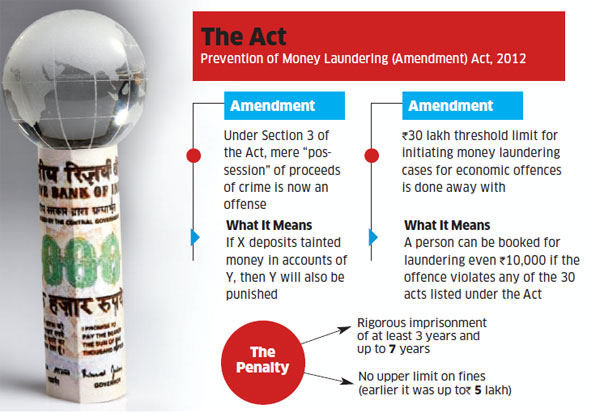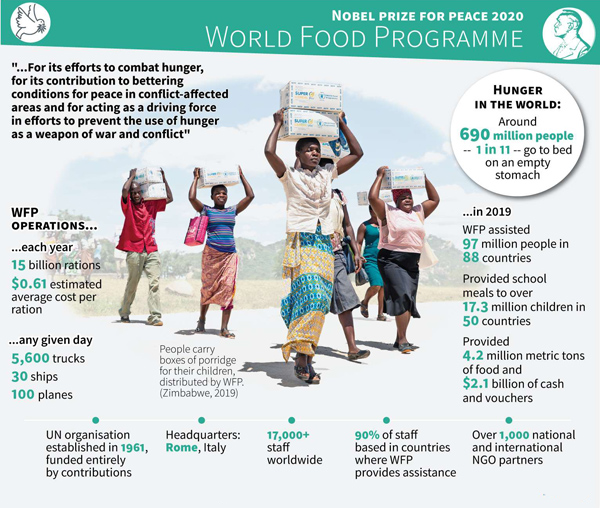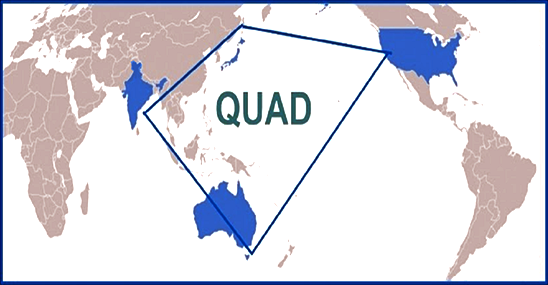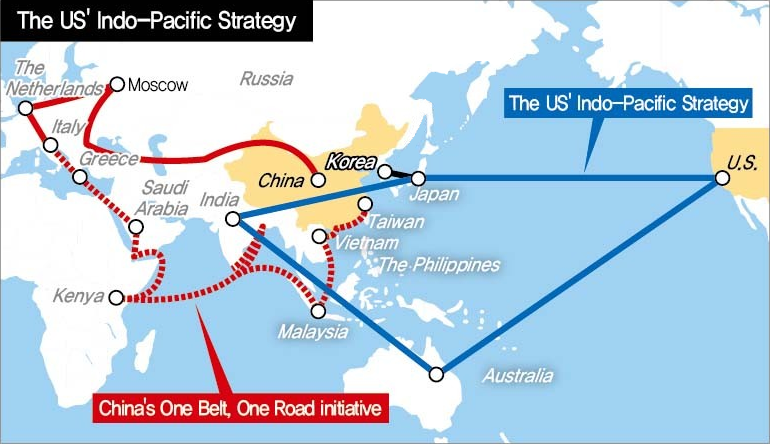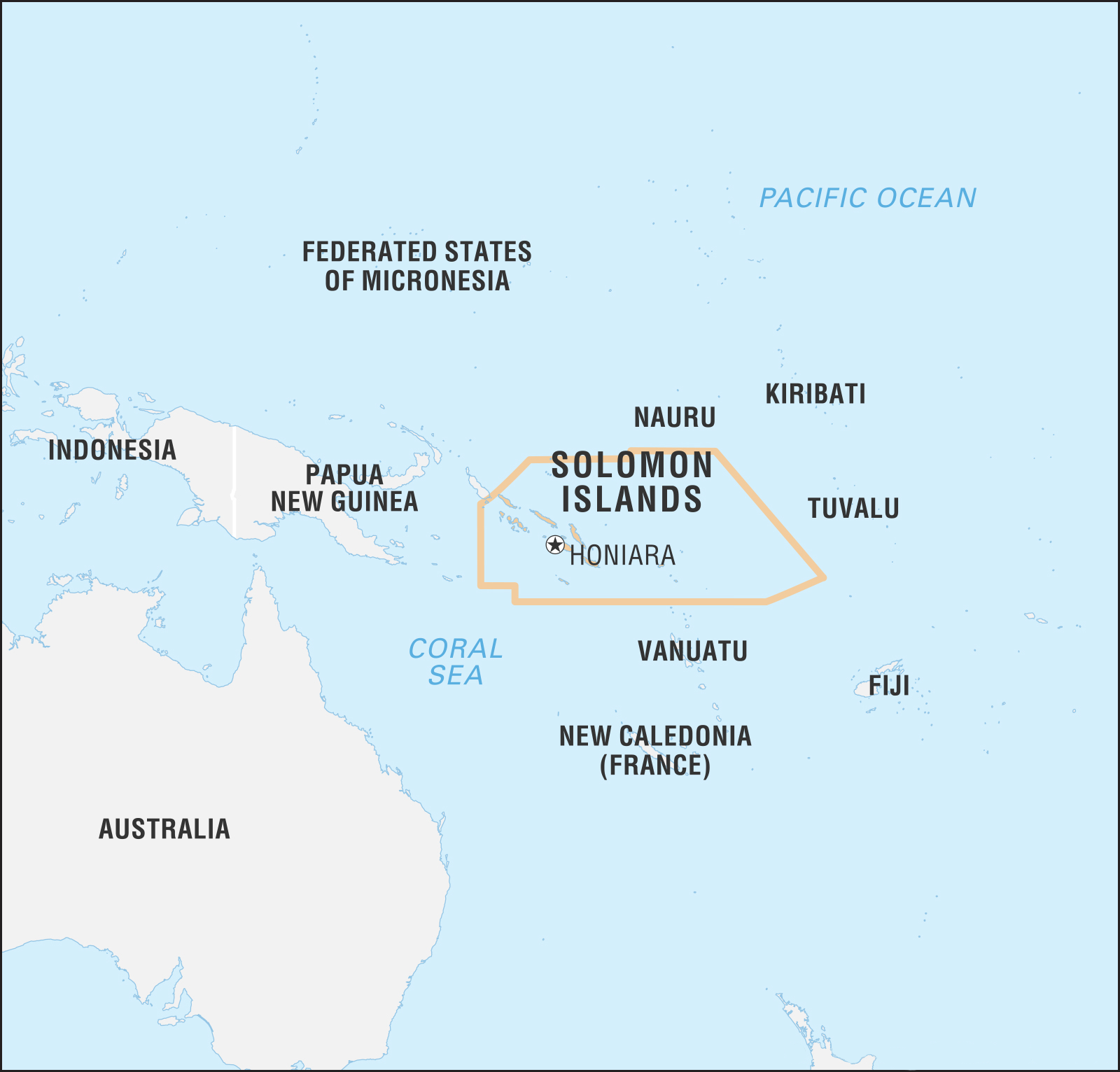Misuse of Prevention of Money Laundering Act
For Prelims: Supreme Court, Money Laundering, Prevention of Money Laundering Act, Enforcement Directorate, Enforcement Case Information Report, Foreign Exchange Management Act.
For Mains: Money Laundering, Challenges to Internal Security Through Communication Networks, Significance and issues with the Prevention of Money Laundering Act 2002 (PMLA), Foreign Exchange Management Act.
Why in News
The Supreme Court (SC) is examining allegations of rampant misuse of Prevention of Money Laundering Act 2002 (PMLA) by the government and the Enforcement Directorate (ED).
What are the Major Allegations?
- Being Used for Ordinary Crimes:
- PMLA is pulled into the investigation of even “ordinary” crimes and assets of genuine victims have been attached.
- PMLA was enacted in response to India’s global commitment (including the Vienna Convention) to combat the menace of money laundering. Instead, rights have been “cribbed, cabined and confined”.
- PMLA was a comprehensive penal statute to counter the threat of money laundering, specifically stemming from trade in narcotics.
- Currently, the offences in the schedule of the Act are extremely overbroad, and in several cases, have absolutely no relation to either narcotics or organised crime.
- Lack of Transparency and Clarity:
- Even the Enforcement Case Information Report (ECIR) - an equivalent of the FIR - is considered an “internal document” and not given to the accused.
- The ED treats itself as an exception to these principles and practises [of criminal procedure law] and chooses to register an ECIR on its own whims and fancies on its own file.
- There is also a lack of clarity about ED’s selection of cases to investigate. The initiation of an investigation by the ED has consequences which have the potential of curtailing the liberty of an individual.
- Even the Enforcement Case Information Report (ECIR) - an equivalent of the FIR - is considered an “internal document” and not given to the accused.
What is the Prevention of Money Laundering Act?
- It forms the core of the legal framework put in place by India to combat Money Laundering.
- The provisions of this act are applicable to all financial institutions, banks (Including RBI), mutual funds, insurance companies, and their financial intermediaries.
- PMLA (Amendment) Act, 2012:
- Adds the concept of ‘reporting entity’ which would include a banking company, financial institution, intermediary etc.
- PMLA, 2002 levied a fine up to Rs 5 lakh, but the amendment act has removed this upper limit.
- It has provided for provisional attachment and confiscation of property of any person involved in such activities.
What is Money Laundering?
- About:
- Money laundering is the process of making large amounts of money generated by criminal activity, such as drug trafficking or terrorist funding, appear to have come from a legitimate source.
- Criminal activities like illegal arms sales, smuggling, drug trafficking and prostitution rings, insider trading, bribery and computer fraud schemes produce large profits.
- Thereby it creates the incentive for money launderers to "legitimise" the ill-gotten gains through money laundering.
- The money generated is called 'dirty money' and money laundering is the process of conversion of 'dirty money', to make it appear as 'legitimate' money.
- Process of Money Laundering:
- Money laundering is a three-stage process :
- Placement: The first stage is when the crime money is injected into the formal financial system.
- Layering: In the second stage, money injected into the system is layered and spread over various transactions with a view to obfuscate the tainted origin of the money.
- Integration: In the third and the final stage, money enters the financial system in such a way that original association with the crime is sought to be wiped out and the money can then be used by the offender as clean money.
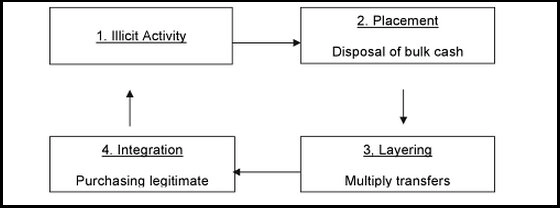
- Some of the Common Methods of Money Laundering:
- Bulk Cash Smuggling, Cash Intensive Businesses, Trade-based laundering, Shell companies and trusts, Round-tripping, Bank Capture, Gambling, Real Estate, Black Salaries, Fictional Loans, Hawala, False invoicing.
- Money laundering is a three-stage process :
What is the Enforcement Directorate?
- Directorate of Enforcement is a specialised financial investigation agency under the Department of Revenue, Ministry of Finance..
- On 1st May 1956, an ‘Enforcement Unit’ was formed, in the Department of Economic Affairs, for handling Exchange Control Laws violations under Foreign Exchange Regulation Act, 1947.
- In the year 1957, this Unit was renamed as ‘Enforcement Directorate’.
- ED enforces the following laws:
- Foreign Exchange Management Act,1999 (FEMA)
- Prevention of Money Laundering Act, 2002 (PMLA)
India and WFP to Supply Wheat to Afghanistan
For Prelims: United Nations World Food Programme, Humanitarian Assistance, Food and Agriculture Organisation, Nobel Prize, Global Report on Food Crisis.
For Mains: Inclusive Growth,India and its Neighbourhood, Important International Institutions, Food Security, Effect of Policies & Politics of Countries on India's Interests, India and WFP, WFP and its Significance.
Why in News?
Recently, India signed an agreement with the United Nations World Food Programme (WFP) for the distribution of 50,000 MT of wheat that it has committed to sending to Afghanistan as part of a humanitarian assistance.
- Earlier, the Delhi Regional Security Dialogue on Afghanistan was held. The meeting called for “urgent humanitarian assistance” to the Afghan people and urged close cooperation and consultation among the regional countries over the Afghan scenario.
- In 2020, India sent more than 20 tonnes of medicines, other equipment and transported 75,000 tonnes of wheat to Afghanistan to address the Covid-19 challenge.
What is the Wheat Agreement About?
- The wheat will be taken through Pakistan to the Afghan border crossing and handed over to WFP officials in Kandahar beginning February 2022.
- Iran has also offered to facilitate some of the wheat through Chabahar port and then on to Afghanistan’s border via Zahedan.
What is the Major Concern in Fulfilling the Agreement?
- The route via Pakistan, which has been closed for all exports from India since 2019, and opened only as an exception, is likely to require several weeks for the transport of the current consignment, as infrastructure and labour required to load and reload the wheat has to be organised.
- Pakistan had shut down all trade with India to protest the government’s changes in Jammu and Kashmir and Article 370 in August 2019.
- Subsequently, the Pakistan government had allowed Afghan exports to India to pass through the Wagah border, making an exception also for medicines from India during the pandemic.
- India has also flown several consignments of medicines and medical equipment to hospitals in Afghanistan on board flights.
What is the United Nations World Food Programme?
- About:
- The World Food Programme (WFP) is the leading humanitarian organisation saving lives and changing lives, delivering food assistance in emergencies and working with communities to improve nutrition and build resilience.
- It was founded in 1961 by the Food and Agriculture Organisation (FAO) and United Nations General Assembly (UNGA) with its headquarters in Rome, Italy.
- It is also a member of the United Nations Sustainable Development Group (UNSDG), a coalition of UN agencies and organisations aimed at fulfilling the Sustainable Development Goals (SDGs).
- The WFP assists 88 countries, and has assisted 97 million people (in 2019) which is the largest number since 2012.
- The WFP has been awarded with the Nobel Prize for Peace 2020 for its efforts to combat hunger, bettering conditions for peace in conflict-affected areas and preventing the use of hunger as a weapon of war and conflict.
- Major Objectives:
- To end hunger by protecting access to food.
- Improving nutrition and achieving food security.
- Supporting the SDG implementation and partnering for its results.
- To focus on emergency assistance as well as rehabilitation and development aid.
- Major Reports:
What is the Relation of WFP with India?
- Background: WFP has been working in India since 1963, with work transitioning from food distribution to technical assistance since the country achieved self-sufficiency in cereal production.
- The areas in which WFP mainly assists in India are:
- Transforming the targeted public distribution system: WFP is working to improve the efficiency, accountability and transparency of India’s own subsidised food distribution system, which brings supplies of wheat, rice, sugar and kerosene oil to around 800 million poor people across the country.
- Fortification of government distributed food: To boost the nutritional value of the Government’s Midday Meal school feeding programme, WFP is pioneering the multi-micronutrient fortification of school meals.
- The pilot project saw rice fortified with iron, which was distributed in a single district, resulting in a 20% drop in anaemia.
- It has also helped tackle malnutrition by fortifying food given to babies and young children in Kerala State.
- Mapping and monitoring of food insecurity: WFP has used Vulnerability Analysis and Mapping softwares to identify India’s most food insecure areas, which allows policy and relief work to be targeted appropriately.
- WFP is also supporting the government’s Poverty and Human Development Monitoring Agency in establishing a State-level Food Security Analysis Unit, working towards the goal of achieving Zero Hunger.
- Strategy Plan for India: According to the country strategy plan for India (2019 – 2023), WFP aims to:
- Enable the most vulnerable people of India to meet their minimum food and nutrition requirements throughout the year.
- Enable people with a high risk of malnutrition, especially women, children and adolescent girls, to have improved nutrition by 2025.
4th Quad Foreign Ministers' Meeting
For Prelims: QUAD, NATO, Indo-Pacific, Quad Vaccine initiative, 5G, COVOVAX, CORBEVAX
For Mains: Groupings & Agreements Involving India and/or Affecting India's Interests, Bilateral Groupings & Agreements, QUAD and its Significance.
Why in News?
Recently, the fourth meeting of the foreign ministers of the QUAD grouping (India, the US, Australia and Japan) was held in Melbourne , Australia.
- The meeting was held amid escalating tension between Russia and North Atlantic Treaty Organization (NATO) countries over Ukraine, the Afghan crisis and increasing concerns over China's "coercion" in the Indo-Pacific region.
What is QUAD?
- It is the grouping of four democracies –India, Australia, the US, and Japan.
- All four nations find a common ground of being democratic nations and also support the common interest of unhindered maritime trade and security.
- The Quad is billed as four democracies with a shared objective to ensure and support a “free, open and prosperous” Indo-Pacific region.
- The idea of Quad was first mooted by Japanese Prime Minister Shinzo Abe in 2007. However, the idea couldn’t move ahead with Australia pulling out of it, apparently due to Chinese pressure.
- Finally in 2017, India, Australia, the US and Japan, came together and formed this “quadrilateral” coalition.
What were the Discussions on Security and Intelligence?
- Called for justice for the 26/11 terror attacks in Mumbai (2008) and the Pathankot airbase attack (2016) for the first time since the group was formed.
- QUAD is already cooperating on sharing intelligence on threats in the Indo-Pacific region. Called on all countries to ensure that territory under their control is not used to launch terror attacks and to expeditiously bring to justice the perpetrators of such attacks.
- They made a veiled reference to China’s actions in the South and East China seas, reaffirming a commitment to a free and open Indo-Pacific, “in which states strive to protect the interests of their people, free from coercion.”
What was their Stand on the Vaccine Initiative?
- Renewed commitment to the “flagship” Quad Vaccine initiative to deliver at least one billion vaccines produced in India by the end of 2022 to Indo-Pacific countries, and to a pledge to donate 1.3 billion vaccine doses globally.
- The Quad vaccine partnership was announced in March 2021.
What is QUAD’s Stand on Myanmar Crisis?
- It remains gravely concerned about the crisis in Myanmar and calls for an end to violence, the release of all those arbitrarily detained, including foreigners, and unhindered humanitarian access.
- It reaffirmed its support for the Association of Southeast Asian Nations (ASEAN) efforts to seek a solution in Myanmar and called on the military regime to urgently implement ASEAN’s Five-Point Consensus and swiftly return Myanmar to the path of democracy.
- It encouraged the international community to work together to support an end to the violence.
What did the Leaders Say on Emerging Technologies?
- Recorded progress on the other fields for cooperation identified during the QUAD summit in 2021, including climate change, critical and emerging technologies, counter-terrorism, infrastructure, Humanitarian-Assistance and Disaster-Relief (HADR) and maritime domain awareness.
- The QUAD is pursuing work on 5G technology and vendor diversification to maintain a diverse, open and interoperable telecommunication ecosystem through collaboration with like-minded partners.
What was India’s Stand in the Meeting?
- India is open to supplying safe and affordable Made in India vaccines, such as COVOVAX and CORBEVAX, under the QUAD vaccine partnership.
- QUAD is building an agenda which seeks to further India’s shared vision of a free, open and inclusive Indo-Pacific.
- India and Australia have pledged to work together for building more trusted and resilient supply chains and ensuring broad and inclusive growth in the strategic Indo-Pacific region.
- Earlier in 2021, the Trade Ministers of India, Japan and Australia have formally launched the Supply Chain Resilience Initiative (SCRI).
- As liberal democracies, India and Australia would continue to work towards a rule-based international order, freedom of navigation in international waters, promoting connectivity, growth and security for all while respecting the territorial integrity and sovereignty of all states.
- India and Australia have pledged to work together for building more trusted and resilient supply chains and ensuring broad and inclusive growth in the strategic Indo-Pacific region.
- It is keen to work together to further peace and stability and economic prosperity in the Indo-Pacific.
- On Myanmar, India pointed to the challenge of insurgency along the Indo-Myanmar border. It also stressed that it is against “national sanctions”. The US has imposed sanctions on a number of leaders of the Myanmar Military.
- It maintained complete diplomatic silence on the Russian threat to invade Ukraine.
US’ Indo-Pacific Strategy
For Prelims: US’ Indo-Pacific strategy, Indo-Pacific Region.
For Mains: Free and open Indo-Pacific, US’ Indo-Pacific strategy, Tackling China’s assertiveness, India’s Role.
Why in News?
Recently, the US administration has announced its long-awaited Indo-Pacific strategy.The document focuses on building collective capacity to deal with challenges in the region.
- These include a focus on challenges from China, advancing the US relationship, a ‘Major Defense Partnership’ with India and supporting its role as a net security provider in the region.
- There is an emphasis on working with other countries not just from the region, but also from beyond.
- Earlier, the European Union had announced that it will reinforce its strategic focus, presence and actions in the Indo-Pacific with the aim of contributing to the stability, security, prosperity and sustainable development of the region.
What are the Key Points of US’ Indo-Pacific strategy?
- Vision of Indo-Pacific: The US will seek an Indo-Pacific that is free and open, connected, prosperous, secure and resilient.
- Free: One of the strategic actions outlined is investing in civil society, a free press and democratic institutions.
- Connections: Within and beyond the region.
- The US says it will work “in flexible groupings” to tackle major issues, “particularly through the QUAD.”
- It will also deepen its (five) regional treaty alliances and work with groups such as ASEAN, the European Union (EU) and NATO.
- AUKUS, a security alliance between Australia, the UK and the US has also been recently launched.
- Prosperity: To advance its prosperity goal for the region, the US’ strategy includes seeking higher labour and environmental standards, helping to establish secure supply chains and investing in clean energy.
- Security: The US has announced that “Integrated deterrence” will form the “cornerstone” of the US’ security plan for the region.
- It will drive initiatives that reinforce deterrence and counter coercion, such as opposing efforts to alter territorial boundaries or undermine the rights of sovereign nations at sea.
- Resilience: The Indo-Pacific faces major transnational challenges.
- Climate change is growing ever-more severe as South Asia’s glaciers melt and the Pacific Islands battle existential rises in sea levels.
- Further,the Indo-Pacific governments grapple with natural disasters, resource scarcity, internal conflict, and governance challenges.
- In this context, US envisages to build regional resilience to 21st century transnational threats, including by:
- Working with allies and partners to develop 2030 and 2050 targets, strategies, plans, and policies consistent with limiting global temperature increase to 1.5 degrees Celsius.
- Reducing regional vulnerability to the impacts of climate change and environmental degradation.
- Role of India: India’s role in the QUAD is an important element of the US-India relationship.
- US will “continue to support India’s rise and regional leadership,” working with India bilaterally and through groups on a range of issues.
- It refers to India as a “like-minded partner” and “driving force” in the QUAD.
- China's action along the Line of Actual Control (i.e., its border conflict with India) has had a “galvanizing impact” on India and US alignment.
- Collaborate in new domains, such as health, space, and cyberspace, deepen economic and technology cooperation, and contribute to a free and open Indo-Pacific.
- China’s Assertiveness: US allies and partners in the region bear much of the effect of China’s assertive policies.
- The economic coercion of Australia.
- The conflict along the Line of Actual Control with India.
- The growing pressure on Taiwan.
- Bullying of Japan, ASEAN countries in the East and South China Seas.
Rice Fortification
For Prelims: Food Fortification and related schemes.
For Mains: Food Fortification and its significance.
Why in News?
The Minister of Consumer Affairs, Food and Public Distribution informed the Rajya Sabha that the government approved the Centrally Sponsored Pilot Scheme on "Fortification of Rice & its Distribution under Public Distribution System" for a period of 3 years beginning in 2019-20 with total outlay of Rs. 174.64 Cr.
What is the Scheme?
- About:
- To address anemia and micro-nutrient deficiency in the country, the Government of India approved this scheme for a period of 3 years in 2019-20.
- Under the Scheme, FCI (Food Corporation of India) has been asked to come up with a comprehensive plan for procurement and distribution of fortified rice in all the Districts of the country under Integrated Child Development Services (ICDS) & Mid-Day Meal (MDM) Scheme from 2021-2022.
- The mid-day meal scheme is now known as PM POSHAN.
- Special focus remains on supplying fortified rice to the 112 specially identified Aspirational Districts of the country.
- Objectives the Scheme:
- Distribution of Fortified Rice through Public Distribution System, to cater 15 Districts in the country - preferably one district per State in the initial phase of Implementation.
- Coverage of NFSA (National Food Security Act) beneficiaries under PDS with Fortified Rice in the selected Districts.
- Facilitate cross learning and sharing of best practices among States/UTs and DoF&PD (Department of Food and Public Distribution).
- To evaluate the provision, coverage and Utilization of Fortified Rice by the target population as well as the efficiency/effectiveness of the consumption of fortified rice in reducing the targeted micronutrient deficiencies in different age and gender groups.
What is Food Fortification and its Need?
- Fortification:
- Fortification is the addition of key vitamins and minerals such as iron, iodine, zinc, Vitamin A & D to staple foods such as rice, milk and salt to improve their nutritional content.
- These nutrients may or may not have been originally present in the food before processing.
- Fortification of Rice:
- According to the Food Ministry, fortification of rice is a cost-effective and complementary strategy to increase vitamin and mineral content in diets.
- According to FSSAI norms, 1 kg fortified rice will contain iron (28 mg-42.5 mg), folic acid (75-125 microgram) and Vitamin B-12 (0.75-1.25 microgram).
- In addition, rice may also be fortified with micronutrients, singly or in combination, with zinc, Vitamin A, Vitamin B1, Vitamin B2, Vitamin B3 and Vitamin B6.
- According to the Food Ministry, fortification of rice is a cost-effective and complementary strategy to increase vitamin and mineral content in diets.
- Need of Fortification:
- India has very high levels of malnutrition among women and children. According to the Food Ministry, every second woman in the country is anemic and every third child is stunted.
- India has slipped to 101st position in the Global Hunger Index (GHI) 2021 of 116 countries, from its 2020 position of 94th.
- The deficiency of micronutrients or micronutrient malnutrition, also known as “hidden hunger”, is a serious health risk.
- Rice is one of India’s staple foods, consumed by about two-thirds of the population. Per capita rice consumption in India is 6.8 kg per month. Therefore, fortifying rice with micronutrients is an option to supplement the diet of the poor.
What are the Initiatives related to Fortification?
- FSSAI Regulations:
- In October 2016, FSSAI operationalized the Food Safety and Standards (Fortification of Foods) Regulations, 2016 for fortifying staples namely Wheat Flour and Rice (with Iron, Vitamin B12 and Folic Acid), Milk and Edible Oil (with Vitamins A and D) and Double Fortified Salt (with Iodine and Iron) to reduce the high burden of micronutrient malnutrition in India.
- Nutritional Strategy:
- India’s National Nutritional strategy, 2017, had listed food fortification as one of the interventions to address anemia, vitamin A and iodine deficiencies apart from supplementation and dietary diversification.
- Milk Fortification Project:
- The Milk Fortification Project was launched by the National Dairy Development Board (NDDB) in collaboration with the World Bank and Tata Trusts, as a pilot project in 2017.
Free Legal Aid
For Prelims: National Legal Service Day, NALSA.
For Mains: Free Legal aid, Related constitutional provisions and laws.
Why in News?
Recently, the Ministry of Law and Justice informed Lok Sabha about the Pan India Legal Awareness and Outreach Campaign, which was launched in October 2021 on the occasion of National Legal Service Day (NLSD).
- The NLSD is celebrated on 9th November every year to spread awareness for ensuring reasonable fair and justice procedure for all citizens.
What is NLSD and Related Constitutional Provisions?
- About:
- NLSD was first started by the Supreme Court of India in 1995 to provide help and support to poor and weaker sections of the society.
- Free legal services are provided in matters before Civil, Criminal and Revenue Courts, Tribunals or any other authority exercising judicial or quasi judicial functions.
- It is observed to make the citizens of the country aware of the various provisions under the Legal Services Authorities Act and the rights of the litigants. On this day, each jurisdiction organizes legal aid camps, Lok adalats, and legal aid programmes.
- Constitutional Provisions:
- Article 39A of the Constitution of India provides that State shall secure that the operation of the legal system promotes justice on a basis of equal opportunity, and shall in particular, provide free legal aid, by suitable legislation or schemes or in any other way, to ensure that opportunities for securing justice are not denied to any citizen by reason of economic or other disability.
- Articles 14 and 22(1) also make it obligatory for the State to ensure equality before law and a legal system which promotes justice on a basis of equal opportunity to all.
What are the Objectives of Legal Service Authorities?
- Provide free legal aid and advice.
- Spread legal awareness.
- Organize lok adalats.
- Promote settlements of disputes through Alternative Dispute Resolution (ADR) Mechanisms. Various kinds of ADR mechanisms are Arbitration, Conciliation, Judicial settlement including settlement through Lok Adalat, or Mediation.
- Provide compensation to victims of crime.
What are the Institutions for providing Free Legal Services?
- National Level:
- National Legal Services Authority (NALSA). It was constituted under the Legal Services Authorities Act, 1987. The Chief Justice of India is the Patron-in-Chief.
- State Level:
- State Legal Services Authority. It is headed by the Chief Justice of the State High Court who is its Patron-in-Chief.
- District Level:
- District Legal Services Authority. The District Judge of the District is its ex-officio Chairman.
- Taluka/Sub-Division Level:
- Taluka/Sub-Divisional Legal Services Committee. It is headed by a senior Civil Judge.
- High Court: High Court Legal Services Committee
- Supreme Court: Supreme Court Legal Services Committee.
Who is Eligible for Getting Free Legal Services?
- Women and children
- Members of SC/ST
- Industrial workmen
- Victims of mass disaster, violence, flood, drought, earthquake, industrial disaster.
- Disabled persons
- Persons in custody
- Those persons who have annual income of less than the amount prescribed by the respective State Government, if the case is before any court other than the Supreme Court, and less than Rs. 5 Lakhs, if the case is before the Supreme Court.
- Victims of Trafficking in Human beings or begar.
Maharaja Surajmal
For Prelims: Maharaja Surajmal, Third Battle of Panipat.
For Mains: Maharaja Surajmal, Role of Important Personalities, contribution of Maharaja Surajmal.
Why in News?
Recently, the Prime Minister has paid tributes to Maharaja Surajmal on his Jayanti.
Who was Maharaja Surajmal?
- He ruled in the 18th century and was the son of the Jat chieftain Badan Singh.
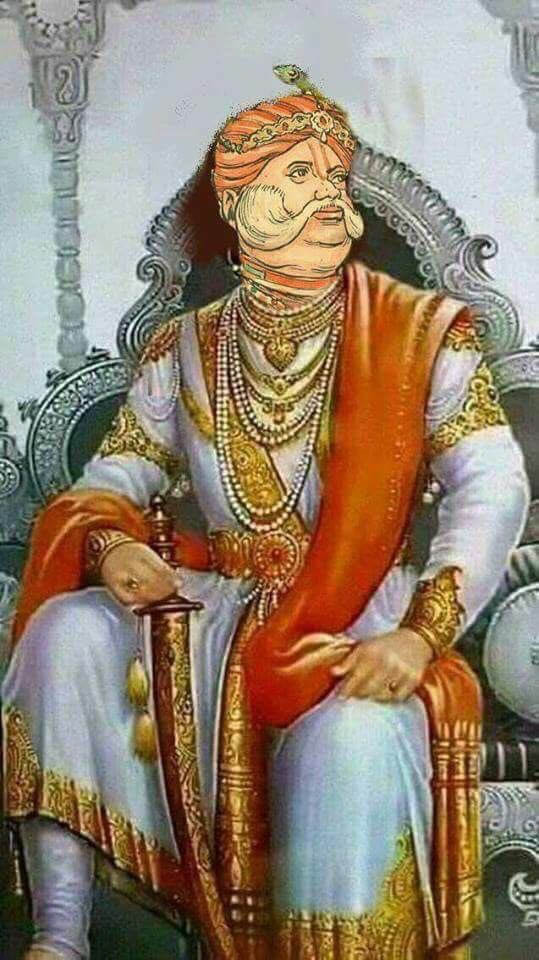
- He was a great leader, a great fighter, a great diplomat and a great statesman of his time.
- He was described as "the Plato of the Jat people" and by a modern writer as the "Jat Odysseus", because of his political sense, steady intellect and clear vision.
- He united various factions of Hindus and Muslims and kept them together.
- He took care of the historical monuments built by the kings of other religions and employed people according to their abilities in higher posts, irrespective of their races.
- He believed that humanity is the only religion of man.
- He visualized “India as one nation” and devoted his life in forging national integration.
- Maharaja Surajmal considered farmers as the most important section of the society and had a lot of respect for them.
- He personally identified the problems of the farmers and introduced reforms to rectify them.
- Some institutions that have been named after him include the Maharaja Surajmal Institute of Technology and Maharaja Surajmal Brij University, Bharatpur.
- It is believed that the Maharaja died in battle in December of 1763 beside the Hindon river, after being ambushed by the army of Mughal chief Najib-ad-Dawlah.
What about the Military Career of Maharaja Surajmal?
- He had a good relationship with Maharaja Jai Singh of the princely state of Jaipur.
- After the death of Jaisingh, his sons Ishwari Singh and Madho Singh started fighting over the princely status as the heirs.
- Surajmal wanted to make the elder son Ishwari Singh the next heir of the princely state, while Maharana Jagat Singh of Udaipur state was in favor of making the younger son Madho Singh the King.
- In the event of this difference, the fight over the throne started. Ishwari Singh won the struggle in March 1747. The battle did not completely end here.
- Madho Singh returned to the battlefield with the Marathas, Rathores, and Sisodia Kings of Udaipur. In such an environment, king Surajmal reached the battlefield with 10,000 soldiers to support Ishwari Singh.
- In this war, Ishwari Singh was victorious and he got the royal text of Jaipur. After this battle, the dunk of Maharaja Surajmal started ringing all over India.
- Later on 1st January 1750 Maharaja Surajmal crushed the Mughal army of Salabat Khan and forced the latter to accept all his terms.
- Later during the civil war among the Mughal Maharaja Surajmal plundered old Delhi in support of Safdar Jung.
- By 1753, Maharaja Surajmal had extended his jurisdiction to Delhi and Feroz Shah Kotla. Angered by this, the Nawab of Delhi, Ghaziuddin instigated the Maratha chieftains against Surajmal.
- The Marathas attacked Bharatpur. He surrounded the fort of Kumher for several months.
- The Marathas could not capture Bharatpur in this attack, but they had to pay the price of this attack in the form of the death of Khanderao Holkar, son of Maratha Sardar Malharrao. After some time the Marathas made a treaty with Surajmal.
- Surajmal had built the impregnable Lohagarh Fort, which the British could not penetrate even after attacking 13 times.
- This is the only fort in the country, which has always been impenetrable.
What is the relation between Maharaja Surajmal and the third Battle of Panipat?
- The Third Battle of Panipat was fought between the Marathas and the invading armies of Afghan general Ahmed Shah Abdali in 1761.
- The battle, fought about 90 km north of Delhi, was won by the Afghans and left about 40,000 troops of the Marathas dead.
- Maharaja Surajmal was among those who played key roles in the battle.
- After the battle, the Marathas lost their preeminent position in north India, which ultimately paved the way for British colonial powers to take over.
Index of Industrial Production
Why in News?
Recently, as per official estimates for the Index of Industrial Production (IIP), India's industrial recovery slowed sharply in December 2021, with output growing just 0.4% year-on-year, and manufacturing activity contracting 0.1%.
- Contrary to expected growth of 2.5%, growth has come in at 0.4% which is disappointing.
What is the Index of Industrial Production?
- IIP is an indicator that measures the changes in the volume of production of industrial products during a given period.
- It is compiled and published monthly by the National Statistical Office (NSO), Ministry of Statistics and Programme Implementation.
- It is a composite indicator that measures the growth rate of industry groups classified under:
- Broad sectors, namely, Mining, Manufacturing, and Electricity.
- Use-based sectors, namely Basic Goods, Capital Goods, and Intermediate Goods.
- Base Year for IIP is 2011-2012.
- Significance of IIP:
- It is used by government agencies including the Ministry of Finance, the Reserve Bank of India, etc, for policy-making purposes.
- IIP remains extremely relevant for the calculation of the quarterly and advance GDP (Gross Domestic Product) estimates.
- About Eight Core Sectors:
- These comprise 40.27% of the weight of items included in the Index of Industrial Production (IIP).
- The eight core sector industries in decreasing order of their weightage: Refinery Products> Electricity> Steel> Coal> Crude Oil> Natural Gas> Cement> Fertilizers.
Solomon Islands
Why in News?
Recently, the US says it will open an embassy in the Solomon Islands, laying out in unusually blunt terms a plan to increase its influence in the South Pacific nation before China becomes “strongly embedded.”
What is the Reason behind the Decision?
- Solomon Islanders cherished their history with Americans on the battlefields of World War II (1939-45), but that the US was in danger of losing its preferential ties as China “aggressively seeks to engage” elite politicians and business people in the Solomon Islands.
- The move comes after rioting rocked the nation of 7,00,000 in November, 2021.
- The riots grew from a peaceful protest and highlighted long-simmering regional rivalries, economic problems and concerns about the country’s increasing links with China.
- The embassy announcement fits with a new Biden administration strategy for the Indo-Pacific and emphasises building partnerships with allies in the region as a way to counter China’s growing influence and ambitions.
- In the Quad meeting held recently, the US has said that it is committed to a “free and open, connected, prosperous, secure, and resilient” Indo-Pacific region.
Where is the Soloman Islands Located?
- Solomon Islands is a nation in Melanesia, east of Papua New Guinea, comprising more than 990 islands. Its capital is Honiara, located on the island of Guadalcanal.
- The Solomon Islands have been inhabited by Melanesian people for at least 30,000 years.
- It consists of a double chain of volcanic islands and coral atolls in Melanesia.
- Melanesia is a subregion of Oceania in the southwestern Pacific Ocean.
- The country comprises most of the Solomons chain—with the exception of Buka and Bougainville, two islands at the northwestern end that form an autonomous region of Papua New Guinea.
- The island is a constitutional monarchy, with the British monarch, represented by a governor-general, serving as the formal head of state. Still, the country, a member of the Commonwealth, is independent, and the governor-general is appointed on the advice of the unicameral National Parliament.
Koalas as Endangered Species: Australia
Why in News?
Recently, Australia has officially classified koalas as ‘endangered’.
Why classified as Endangered and its Significance?
- Classification as Endangered:
- Australia’s Koala population has been on the road to extinction for over two decades now. The number of Koalas in NSW (New South Wales) declined by between 33% and 61% since 2001.
- But despite several demands by animal rights groups and conservationists, the government has been accused of doing little to protect the species. Koalas were classified as “vulnerable” only in 2012.
- During the catastrophic 2019 bushfires in Australia, now known as the ‘Black Summer’, an estimated 60,000 koalas were impacted, with vast swathes of their habitat being blackened and rendered unliveable.
- Another major threat is the spread of chlamydia, a sexually transmitted disease known to cause blindness and cysts in the koalas reproductive tract.
- Significance:
- The Endangered status of the koala means they and their forest homes should be provided with greater protection under Australia’s national environmental law.
What are the Key Things about Koalas?
- About:
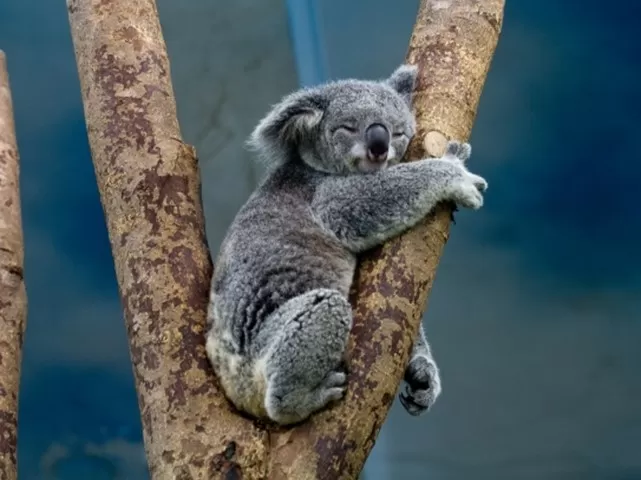
- Koala is (Phascolarctos cinereus) an arboreal (lives in trees) marsupial.
- A marsupial is born in a very incomplete state. They are minute, hairless and with hind limbs only partially formed. Around 2/3rd of them live in Australia. The other third live mostly in South America.
- Instead of the placenta, the mother’s milk nourishes the young and allows it to grow and develop.
- They share a number of characteristics with wombats, who are their closest living relatives, including a backward-facing pouch.
- Koala is (Phascolarctos cinereus) an arboreal (lives in trees) marsupial.
- Habitat:
- The typical habitat for Koalas is open eucalypt woodlands, and the leaves of these trees make up most of their diet. In terms of societal behavior, Koalas are asocial animals and typically emotional bonding is seen only between mothers and dependent offspring.
- They are endemic to Australia.
- Due to the low nutrient levels of the Eucalyptus leaves they feed on, the koala can sleep up to 18 hours each day.
- IUCN status:
- Vulnerable
- Threats:
- Habitat destruction, climate change & severe weather (Droughts, extreme temperatures).

